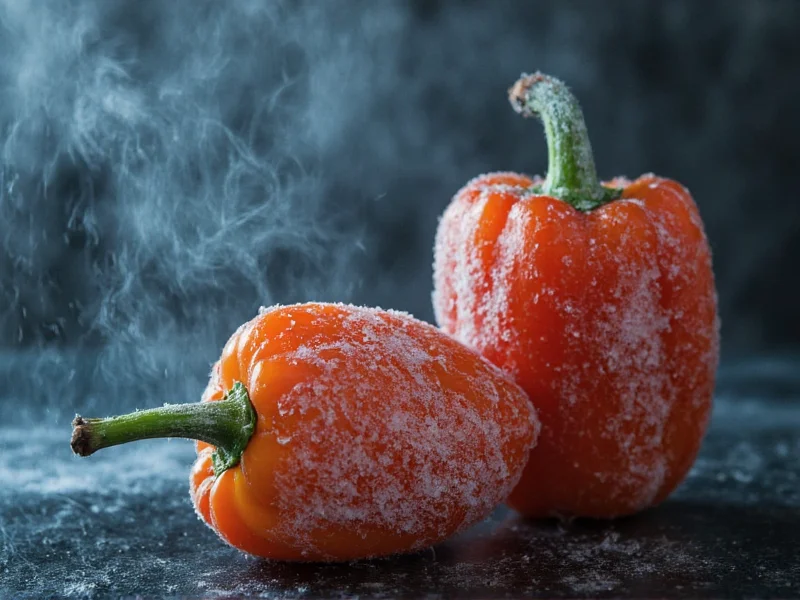Ghost peppers (Bhut Jolokia) rank among the world's hottest chilies, and proper preservation is essential for home growers and culinary enthusiasts. Freezing offers significant advantages over other preservation methods while maintaining the pepper's formidable heat profile.
The Science Behind Freezing Ghost Peppers
When properly frozen, ghost peppers retain their capsaicinoids—the compounds responsible for their heat—more effectively than drying or pickling. Research from the Journal of Food Science shows that frozen peppers maintain 90-95% of their original capsaicin content after 6 months, compared to 70-80% for dried peppers. The freezing process halts enzymatic degradation that would otherwise diminish flavor and heat over time.
Step-by-Step Guide to Freezing Ghost Peppers
Follow these professional preservation techniques to maximize quality and safety:
- Preparation: Wear nitrile gloves and eye protection. Wash peppers under cold water and pat completely dry with paper towels. Moisture causes ice crystals that damage cell structure.
- Whole vs. Chopped: For maximum longevity (12 months), freeze whole. For immediate cooking use (6-8 months), chop or slice first. Never use퀵silver or regular plastic bags—opt for vacuum-sealed or heavy-duty freezer bags.
- Flash Freezing: Arrange peppers in a single layer on a parchment-lined baking sheet. Freeze for 2 hours before transferring to storage containers. This prevents clumping.
- Packaging: Remove as much air as possible from containers. For vacuum sealing, use a moisture barrier setting to prevent freezer burn.
- Labeling: Include date and Scoville rating (1,000,000+ SHU) for future reference.
How Freezing Affects Ghost Pepper Characteristics
Understanding the changes that occur during freezing helps manage expectations:
| Characteristic | Before Freezing | After Proper Freezing | After Improper Freezing |
|---|---|---|---|
| Heat Level | 1,000,000+ SHU | 950,000-980,000 SHU | 700,000-800,000 SHU |
| Texture | Firm, crisp | Slightly softer but usable | Mushy, waterlogged |
| Flavor Complexity | Full floral notes | 90% retained | Significantly diminished |
| Storage Duration | N/A | 10-12 months | 3-4 months |
Thawing and Using Frozen Ghost Peppers
For optimal results when using frozen ghost peppers:
- Direct cooking: Add frozen peppers directly to hot dishes like stews or sauces—thawing releases excessive moisture
- Chopping: Work with peppers while still partially frozen for cleaner cuts
- Safety: Continue wearing gloves during thawing as capsaicin remains active
- Moisture control: Pat thawed peppers dry with paper towels before using in dry rubs
Freezing vs. Other Preservation Methods
While freezing ghost peppers preserves heat better than alternatives, each method has specific applications:
- Drying: Reduces heat by 20-30% but concentrates flavor; ideal for powders and long-term storage (2+ years)
- Pickling: Preserves texture but mellows heat by 15-25%; best for immediate consumption within 6 months
- Refrigeration: Only maintains quality for 2-3 weeks; not recommended for long-term storage
- Oil preservation: Risk of botulism without proper acidification; not recommended for home preservation
Safety Considerations for Handling Frozen Ghost Peppers
Ghost peppers require special handling precautions due to their extreme capsaicin concentration:
- Always wear nitrile gloves (latex won't protect against capsaicin)
- Avoid touching face or eyes during handling—even frozen peppers transfer capsaicin
- Work in well-ventilated areas to prevent inhalation of volatile compounds
- Have dairy products (milk, yogurt) nearby to neutralize accidental exposure
- Never use blenders or food processors without proper ventilation—creates inhalable capsaicin aerosols
Troubleshooting Common Freezing Issues
Address these frequent problems when preserving ghost peppers:
- Freezer burn: Caused by air exposure; prevent with vacuum sealing and use within 12 months
- Ice crystals: Results from improper drying before freezing; always pat peppers completely dry
- Heat loss: Occurs with temperature fluctuations; maintain consistent freezer temperature below 0°F (-18°C)
- Odor transfer: Ghost peppers absorb surrounding flavors; store in dedicated airtight containers
Maximizing Culinary Applications
Frozen ghost peppers work exceptionally well in specific culinary applications:
- Sauces and hot sauces: Add directly to simmering liquids for even heat distribution
- Marinades: Freeze peppers with citrus juice for convenient flavor-infused ice cubes
- Baking: Incorporate frozen pepper puree into breads and crackers for controlled heat
- Cocktails: Use frozen pepper-infused ice cubes for spicy margaritas without dilution











 浙公网安备
33010002000092号
浙公网安备
33010002000092号 浙B2-20120091-4
浙B2-20120091-4